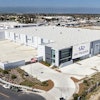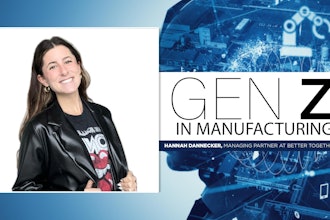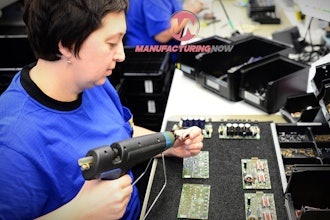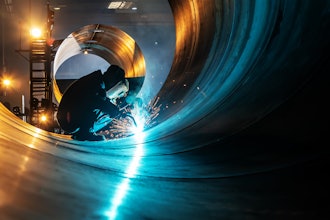
Infor
High Tech Manufacturing
Four trends driving high tech
manufacturers to collaborate
with non-high tech companies
The lines have been increasingly blurring between high tech and non-high tech manufacturing—in large part due
to the proliferation of technology into everyday consumer and business products, coupled with the transformation
of society’s infrastructure from pervasive Internet connectivity. This has major implications for how high tech
manufacturers operate today and how they’ll need to operate in the future. C-level executives at high tech
manufacturing companies need to respond to this shift by transforming their business strategies and operations to
effectively collaborate with non-high tech companies.
The first step in managing this transition is to understand the forces driving the integration of high tech
manufacturing and other industries. Read on to learn about four trends that are compelling high tech
manufacturers to collaborate with non-tech companies, and what manufacturers can do to make the
collaboration work.
High Tech Manufacturing Perspectives
1. Technology has
been democratized
Over the past 25 years, technology has progressively
moved out of the back office of businesses and other
organizations—first into the front offices of business,
and then into everyday consumer products. The
resulting growth of the personal computer and mobile
phone markets over the last few decades have been
followed more recently by the increasing acceptance
of bring-your-own-technology (BYOT) policies at many
organizations and institutions. According to a report by
market research firm, Global Industry Analysts, this
trend shows no sign of slowing down: “The global
market for embedded systems is expected to reach
US $234Billion by 2020, driven by the steady growth
in the production and sales of consumer electronic
devices and increased investment in automation
technologies in the manufacturing sector.”1
2. Society has been
permanently transformed
The integration of technology into what were
traditionally low-tech products has not only changed
how people use those products, but also transformed
how people communicate with each other and with
businesses (such as via social networking), and even
how people communicate with products (such as via
intelligent personal assistants and other artificial
intelligence-based interfaces). Technology helped
create the self-service society in which people are
accustomed—and often more comfortable—handling
interactions with businesses and government
institutions without direct support from another
human being.
3. Major industries have
been transformed
The democratization of technology and the
transformation of society that it facilitated are
impacting virtually every major industry. In high tech
manufacturing, the trends are causing an upheaval.
According to a recent report by the MPI Group, very
few manufacturers can manage all facets of
manufacturing if they want high tech in their products:
“High tech companies have evolved from sellers of
electronic components to developers of modules
and systems that offer solutions for manufacturers
in need of digital functionality. This is critical because
there isn’t enough high tech capability (e.g.,
intellectual property) and capacity (e.g., equipment,
processes) at most lower-tech manufacturers to
embed electronics into their products.”2
Four trends compelling high tech manufacturers
to collaborate with non-high tech companies:
■ Technology has been democratized.
■ Society has been permanently transformed as a result.
■ Major industries have been transformed.
■ High tech companies can no longer rely purely
on innovation.
High Tech Manufacturing Perspectives
This puts growing pressure on leaders of high tech
companies. Chief executive officers (CEOs), chief
financial officers (CFOs), chief marketing officers
(CMOs), production executives, and supply chain
management executives now face a different set of
business challenges. It’s essential they understand the
impact of major trends on their individual roles
and responsibilities.
4. Innovation alone isn’t
enough for high tech
Not long ago, high tech manufacturers could depend
on the continuous development of innovative new
products and capabilities to assure their success.
Innovation is still important, of course, but high tech
companies are increasingly being held to the same
standards for deliverability, quality, and cost that have
always been the critical success factors for their
counterparts in non-high tech industries.
It takes more to impress today
A few years ago, launching non-tech products with
Internet connectivity would have been seen as truly
innovative. But today, connectivity is a parity capability
for a wide range of products. For example, consumer
electronics products with the ability to connect to
the Internet accounted for 91% of industry revenues,
according to a report by Strategy Analytics.3 As a
result, product companies need to offer more
sophisticated technology-based innovation to
differentiate their companies and their products.
Companies are being held
accountable for their
marketing claims
There have been several examples in recent years of
companies being exposed for making misleading or
fraudulent claims about the capabilities of their
products. The most notorious and costly example is
Volkswagen’s use of software that was designed to
detect when a diesel vehicle was being tested for
emissions, and then adjust the vehicle’s carbon
dioxide (CO2) emissions so that it would meet
emissions requirements. In an October 2016
settlement with the US Federal Trade Commission
(FTC), Volkswagen® agreed to give owners and
lessees of affected Volkswagen and Audi 2.0-liter
diesel vehicles up to $10 billion USD as a remedy for
making the false claims.4
Another example is the March 2015 settlement with
the FTC, where Sony® and its advertising agency for
the PlayStation Vita®, Deutsch LA, were barred from
making misleading advertising claims about the Vita
handheld gaming console. Sony was found to have
made false advertising claims about several
technology features of the device and was ordered by
the FTC to give anyone who bought the console
before June 1, 2012 a $25 cash credit or $50
merchandise voucher.5 The FTC also alleged that
Deutsch LA misled consumers by urging its
employees to promote the product on Twitter without
the employees disclosing their connection to the
advertising agency.
These are just two examples of emboldened
regulators holding companies accountable for
misleading the public. Such actions can prove costly
to the business results and brand images of
companies that get exposed.
High Tech Manufacturing Perspectives
High tech companies are
getting called on quality issues
No matter how innovative, flashy, or anticipated a
product might be, high tech companies can also get
punished in the marketplace if those products don’t
measure up to quality. For instance, despite early
reviews that claimed the Samsung Galaxy Note7 was
“one of the best smartphones on the market,”6
Samsung was soon forced to recall the device due to
potential overheating issues.7 This resulted in a recall
of one million devices in the US alone.
The right technology can help
make things clearer
Fortunately, advances in information technology (IT)
have kept pace with these changes and can help
leaders at high tech companies better understand
how major trends are impacting their companies and
what they can do about it.
For instance, a new generation of collaboration
capabilities embedded in traditional enterprise
solutions allow a manufacturer’s employees and
(when appropriate) a partners’ employees to share
information, streamline workflows, and better
understand the business context and implications of
their actions. Big Data analytics and cognitive
computing (such as data mining, pattern recognition,
and natural language simulation that mimic the way
the human brain works) are some of the other tools
available that can help manufacturers develop
effective responses to these external changes.
Adopting a cloud computing strategy can help high
tech manufacturers significantly reduce IT capital
investment requirements to free up resources to
invest in other initiatives that help facilitate business
transformation. With a cloud strategy, manufacturers
can scale IT infrastructures faster to respond to new
business opportunities. These advanced capabilities
can be deployed to support a new “as a service”
business model. According to an Accenture report:
“Cloud, analytics, and automation architectures
behind ‘as a service’ accelerate innovation, reduce
costs, and grow revenue. Enabled by these plug-in,
scalable, consumption-based services, high tech
companies can achieve significant, measurable
business outcomes.”8
But the same Accenture report also offers words of
caution: “Despite ongoing digital investments, few
high tech companies have a clear and disciplined
focus on growth and transformation. Without
redefining how they plan, make, sell, and manage,
many high tech companies are surrendering future
growth potential for short-term gains.”
The democratization of technology and the
transformation of society that it facilitated are
impacting virtually every major industry.
In high tech
manufacturing,
the trends are
causing an
upheaval.
1. Global Industry Analysts, Inc., “Embedded Systems—A Global Strategic Business Report,” April 2, 2015, press release.
2. “High Expectations for High-Tech Value Chains,” The MPI Group, June 2016.
3. David Watkins, “Connected CE Devices Market Forecast: GLOBAL 2009-2019,” Strategy Analytics, July 28, 2015.
4. “Federal Judge Approves FTC Order for Owners of Certain Volkswagen and Audi ‘Clean’ Diesels to Receive Compensation,” Federal Trade Commission,
October 25, 2016, press release.
5. “FTC Approves Final Orders Related to False Advertising by Sony Computer Entertainment America and Its Ad Agency Deutsch LA for PS Vita Game
Console,” Federal Trade Commission, March 31,2015, press release.
6. Ajay Kumar, Sascha Segan, “Samsung Galaxy Note 7” product review, PC Magazine, August 26, 2016.
7. “Samsung expands recall to all Galaxy Note7 devices,” Samsung.com.
8. Sammi Luukkonen, “Accelerating Digital Performance in High-Tech,” Accenture, July, 2016.
What to do next
Learn more about
Infor High Tech & Electronics
Copyright ©2017 Infor. All rights reserved. The word and design marks set forth herein are trademarks and/or registered trademarks of Infor and/or related
affiliates and subsidiaries. All other trademarks listed herein are the property of their respective owners. www.infor.com.
641 Avenue of the Americas, New York, NY 10011
Share this :
INF-1600549-en-US-1216-1
To successfully address prevailing industry trends, high tech manufacturing executives need to understand
the significant role technology can play in to building synergy between their companies and companies of
other industries.
This will likely take a multi-step approach. First, high tech manufacturers need to gain insight into the root causes
of the changes taking place in their markets. Manufacturers then need to use this insight to help uncover where
there are new opportunities. Only then can manufacturers seek out new partnerships in new industries to better
position their companies for the industry’s changing dynamics.
The situation calls for bold actions. High tech manufacturers will likely see increasing opportunities to partner with
non-high tech product companies that are attempting to meet their customers’ demands for enhanced
technological capabilities. Of course, these high tech companies’ competitors will also be presented with the
same opportunities. By investing the time to truly understand the market forces requiring partnerships between
the high tech industry and other non-high tech industries, and then using this knowledge to develop a strategic
response, manufacturers will be able to turn a challenge into an opportunity.




















